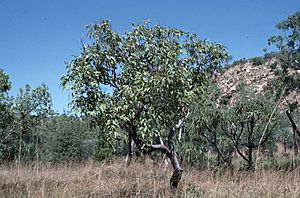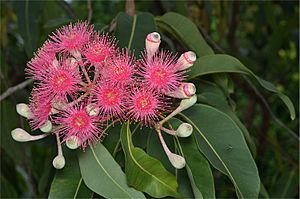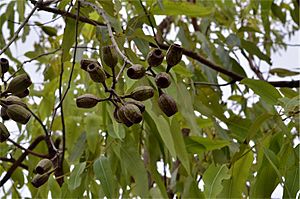Swamp bloodwood facts for kids
Quick facts for kids Swamp bloodwood |
|
|---|---|
 |
|
| Corymbia ptychocarpa at March Fly Glen, Wunaamin Miliwundi Ranges | |
| Scientific classification | |
| Genus: |
Corymbia
|
| Species: |
ptychocarpa
|
| Synonyms | |
|
Eucalyptus ptychocarpa F.Muell. |
|
The Swamp Bloodwood or Spring Bloodwood (scientific name: Corymbia ptychocarpa) is a special type of tree. It grows only in northwestern Australia, meaning it's endemic to that area.
This tree has rough bark on its trunk and branches. Its adult leaves are shaped like wide spearheads. When it flowers, you'll see groups of seven flower buds. The flowers can be creamy yellow, pink, or red. After flowering, it grows barrel-shaped, ribbed fruits.
Contents
What Does the Swamp Bloodwood Look Like?
The Swamp Bloodwood is a tree that usually grows between 4.5 and 20 meters (about 15 to 65 feet) tall. It has thick, rough, brownish bark that looks like a checkerboard pattern on its trunk and branches.
When the tree is young, it can look a bit crooked and its branches might droop.
Leaves
Young Swamp Bloodwood plants have leaves that are oblong, round, or egg-shaped. These leaves can be quite large, from 60 to 300 millimeters (about 2.4 to 11.8 inches) long and 70 to 130 millimeters (about 2.8 to 5.1 inches) wide. They have a small stem called a petiole.
Adult leaves are tough and leathery. They are paler on the underside and shaped like a wide spearhead. These leaves are even bigger, measuring 110 to 460 millimeters (about 4.3 to 18.1 inches) long and 27 to 130 millimeters (about 1.1 to 5.1 inches) wide. Their petioles are 15 to 40 millimeters (about 0.6 to 1.6 inches) long. The main vein in the middle of the leaf is pale yellow, standing out against the green leaf blade.
Flowers and Fruit
The flowers of the Swamp Bloodwood grow at the ends of its branches. They appear on a branched stalk called a peduncle, which is 10 to 60 millimeters (about 0.4 to 2.4 inches) long. Each branch of this stalk holds seven flower buds. These buds sit on smaller stalks called pedicels, which are 10 to 34 millimeters (about 0.4 to 1.3 inches) long.
Mature flower buds are oval or pear-shaped. They are 13 to 24 millimeters (about 0.5 to 0.9 inches) long and 11 to 18 millimeters (about 0.4 to 0.7 inches) wide. The top part of the bud, which covers the flower, is rounded or cone-shaped.
Swamp Bloodwood trees bloom from February to May. Their flowers can be creamy yellow, pink, or red.
After flowering, the tree produces woody, barrel-shaped fruits. These fruits are 32 to 55 millimeters (about 1.3 to 2.2 inches) long and 26 to 45 millimeters (about 1.0 to 1.8 inches) wide. They have about eight sharp ribs on their sides. The parts that release the seeds are hidden inside the fruit.
Where Does the Swamp Bloodwood Grow?
The Swamp Bloodwood tree is found across northwestern Australia. You can see it in the Kimberley region of Western Australia. It also grows throughout the Top End of the Northern Territory. Its range extends to near Doomadgee in far north-western Queensland.
This tree prefers sandy soils and areas near water. It often grows along rivers and streams or close to natural springs. In the Northern Territory, it is found in places like the Arnhem Plateau and the Daly Basin.
Sometimes, the Swamp Bloodwood is planted as a street tree. You can find it lining streets in Queensland cities like Cairns and Townsville.



